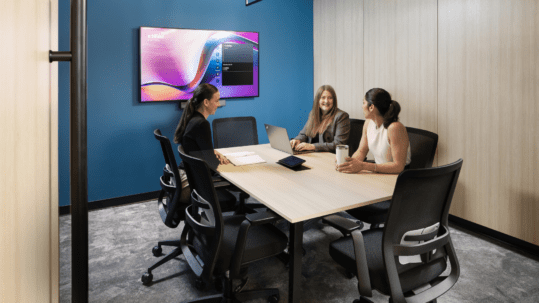While designing an office space requires a lot of creativity, data and analysis come into play as well. You may not think data is pivotal in designing office space, but it is. Going beyond headcount, it’s important to consider everything from typical occupancy numbers, forecasts for hiring, company goals, industry trends, and more. When done properly, data can be used to create an office environment that not only meets the needs of your business but also enhances and celebrates your unique company culture.
Let us dig a bit deeper into how data elements factor into office design.
Occupancy Numbers
Where do you stand in terms of occupancy numbers? You may think that occupancy is simply the basis of your headcount, but it goes beyond that. Do all your employees come into the office every day? For those that intend to come in daily, what is their vacation and sick time allotment on an annual basis? All of this data will factor into occupancy.
If your office allows for flexibility in terms of how people work, you may also see the numbers of people physically in the office drive downward. Is working from home an option for many employees? If so, what is the average number of days people come into the office each week?
The goal here is to figure out the average occupancy within the office at any given time. You may end up with a design where everyone has a cubicle or office space. You could also end up with more of a flex space, where people work in a variety of locations daily depending on who is in the office or not. Why set up and design an office space for 100 people when, on average, you only have 60 in the office? Make use of every inch of your existing square footage with an experiential office design!
Forecasts for Hiring
Do you have plans to either expand or shrink the size of your employee base over the next few years? If you plan to double the number of employees you have over the next five years, go with an office design that meets the needs of that bigger employee base now. If you do not have dedicated space for them today, now is the time to invest in a scalable office design.
It is important to think about forecasts for hiring as it will help you avoid having to do multiple redesigns over a short period of time. Say you have 50 employees today, but in a few years, you expect to have another 50 join the team. If you design a space for 50 now, but it is not something you can scale, or you lack the square footage to even do so, you’ll need to make big changes when the future new employees join . the team. The major expense of doing a whole new office move and redesign makes what you are doing now wasteful. Plan for today, but also plan for the coming years by considering your intentions for hiring.
Company Goals
What are some of the goals of your company? Who are you trying to attract when it comes to employees? All these factors are important to consider for your office design. If you want to attract and keep the best Millennial talent, for example, you’ll want more open concept spaces. Millennials enjoy having areas to collaborate with one another and so building open spaces where they can come together to share ideas, work through engagement is important. If Millennials are not your target, you may want to go with the different office design.
Your company goals will shape largely where you end up with office design. Technology companies may want a space that showcases their vision. More traditional companies may seek designs that keep them ground to their roots. Ultimately, you’re more likely to design an office environment that aligns with your bigger, overarching company goals by keeping them top of mind throughout the entire process.
Industry Trends
Are there trends in the industry that will impact your office design in the short and long-term? Likely one of the most common trends that companies must learn to navigate now is work from home. More employees than ever seek this option, so plan for it when it comes to office design. It’s also important to consider other industry trends, such as having dedicated office spaces, cafeterias, common areas, relaxation rooms, and more. Staying up with the latest trends in the industry will ensure your new office environment meets the needs of your employees and help you acquire new talent.
In the end, data can influence the entire direction of your office design. At the core of our company lies the Aura Integrated Experience, our unique approach to delivering a seamless execution of your design-build project. Taking all the data elements discussed above into consideration, we work closely with you to build an understanding of your needs and expectations; your space and location requirements; and the type of office environment that would best fit your company culture. In doing so, we create experiential office environments that will meet your needs in the short and long-term.
Reach out to us for a complimentary design consultation and get started today!






